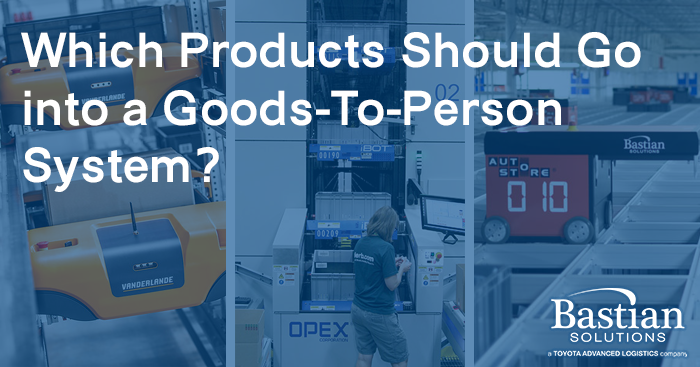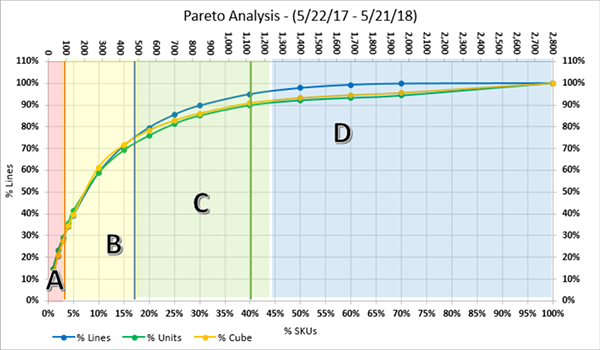
Which Products Should Go into a Goods-To-Person System?
Ahmed Arif | 03 January 2019
As labor costs increase the marginal cost to ship goods, as well as real estate costs raising the fixed cost for operations, automated systems are realizing substantial ROI numbers more than ever before. Goods-to-person technologies are frequently being used to support production and distribution operations. They reduce the amount of time a picker or kit-builder spends moving from one location to the next, allowing employees to spend more time being actively productive.
However, implementing a goods-to-person (GTP) system isn’t just a plug-and-play application. Specific integration points and a well-thought-out operational plan are essential to executing a GTP project that is optimized for a business. Among many factors, the decision of which products to put into the GTP system will weigh heavily on the sizing and configuration of the system as well as the overall success of the project.
Determining What to Put in a Goods-to-Person System
A Data Analytics Approach
The first step in the analysis of which products will go into a GTP system is to understand the order distribution of the products. The interrelationships of the different factors in a business’s order profile, as well as their impact on how to properly configure a goods-to-person system, are complex, but there are a few generalities. Among others, the following are a good place to start:
SKU Count - This should account for future SKU proliferation. It will help determine the number of locations in the GTP system. Many systems can store multiple SKUs in a single storage bin, separated by dividers. However, larger or faster-running SKUs may need multiple bins to prevent excessive replenishment requirements.

Pareto - A Pareto analysis is the measure of how skewed a business’s inventory movement is. A typical metric is that 80% of a facility’s outbound volume comes from 20% of its SKUs. It is helpful to understand how the product moves from a standpoint of individual units (total picks), order lines (GTP bin presentations), and “cube” movement (differently sized items should be treated differently). This data can be used as input to develop useful categories of product movement, such as A, B, C, and D movers. A steeper Pareto (such as 90/10 distribution) could lend well to a top-driven GTP system such as AutoStore. A flatter Pareto (such as 70/30) may necessitate a system with more immediate access to every SKU such as Perfect Pick.
Operational constraints - Above generalizations in the Pareto should not be taken as a sole discriminator in GTP selection. Various configurations (especially physical layout) can have a profound impact on how a system operates. Additionally, the ability to batch orders together could change how a system would be implemented.
Physical constraints - These can range from the facility floorspace and ceiling clear height to product characteristics such as size and material type. For example, special considerations need to be made for “puffy” items such as winter apparel in a GTP system.
Product Velocity in Goods-to-Person Systems
Deciding which products should go into the goods-to-person system will vary from one business to another based on their goals. Many people assume that since a GTP system is so fast that they should put the “A” movers into the system. While there are cases where this makes sense, it is common to put the “B” and “C” movers into the system. There are several reasons for this, including the following:
- The speed of picking “A” movers will require frequent replenishment. Especially if this replenishment is done at the pallet level, it may make sense to separate those items from the GTP system, slotting them in a high-density pick area. This will generally have the effect of increasing the pick rate of those SKUs since the time pickers previously spent walking past the “B” and “C” SKUs in a more manual system is eliminated, allowing them to spend more time picking.
- The price per location for goods-to-person systems is higher than static rack, so placing “D” movers that may just sit idle could be excessive CAPEX with minimal ROI in some circumstances for that SKU category.
Of course, there are factors that could determine the above to be inaccurate for a given application. For example, some businesses see a substantial ROI by placing their “A” movers into a GTP system to simplify receiving processes (more items traveling the same path). Others have a strong ROI with the complementing traits of inventory control and accuracy in the GTP system being higher than a racking system, so they have found benefits by slotting “A” movers into the system as well.
Conversely, some facilities slot their “D” movers into the system if storage space is a concern. Some GTP systems have significantly denser storage capacity than any other medium, and the ability to stay in an existing building instead of expanding or moving outweighs the increased storage price.
With so many factors used to determine the optimal configuration of a goods-to-person system, it can be difficult to ensure the ROI is maximized for an automation project involving this technology. Bastian Solutions has integrated these types of systems from multiple manufacturers. Data analysis is the first step to making the right decision on whether to pursue a GTP project. The analysis results can then be used to choose the right manufacturer in the right configuration.
If you’re considering whether a goods-to-person system is right for your operation, contact us to help.
As the Senior Director of Regional Office Solutions for Bastian Solutions, Ahmed and his teams are responsible for helping our customers achieve their goals in manufacturing, distribution, warehouse management and logistics. A graduate of Purdue University, Ahmed has been with Bastian Solutions for more than sixteen years in a variety of roles.
Comments
No comments have been posted to this Blog Post
Leave a Reply
Your email address will not be published.
Comment
Thank you for your comment.